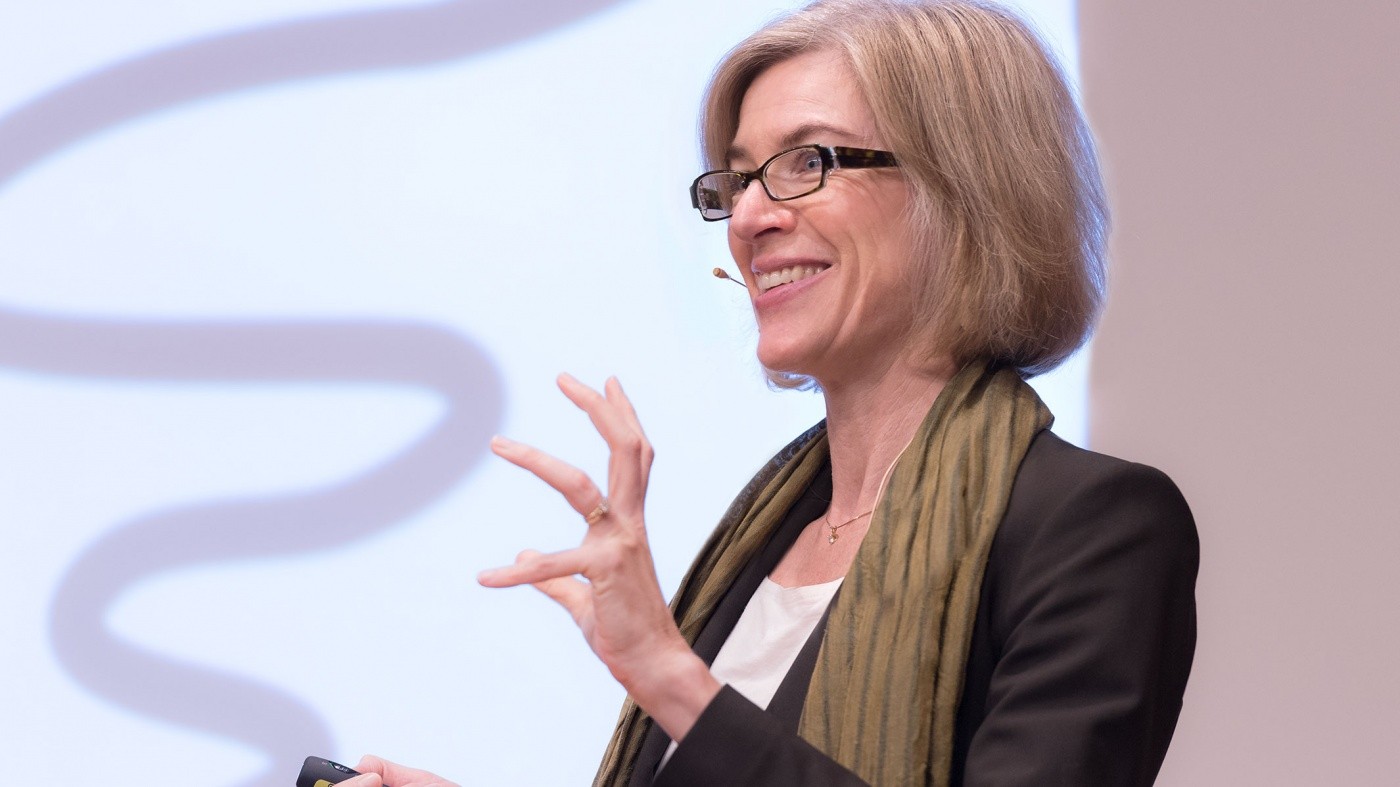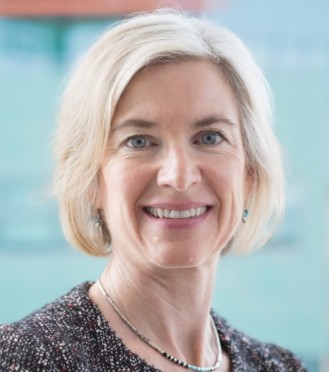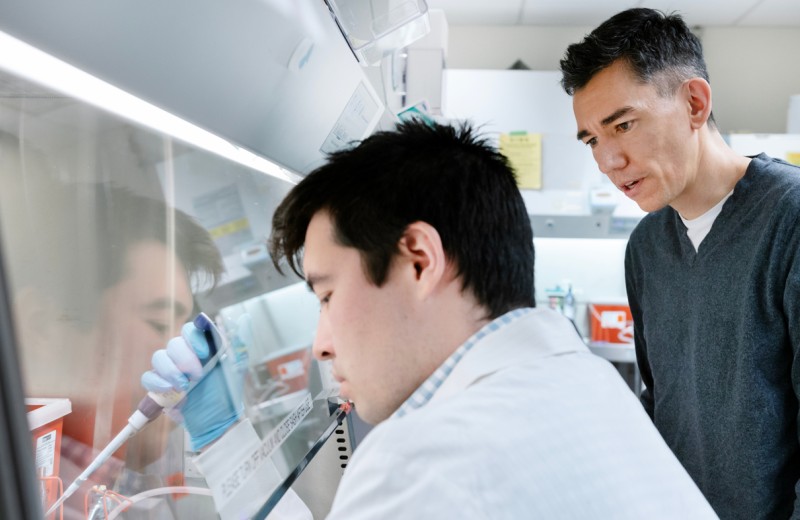
Jennifer Doudna, PhD, described the past, present, and future of her ground-breaking CRISPR technology during the 2016 Distinguished Lecture at the Gladstone Institutes. [Photo: Chris Goodfellow, Gladstone Institutes]
Since it was first described in 1993, Clustered Regularly Interspaced Short Palindromic Repeats, or CRISPR, has revolutionized biomedical research. With advanced technology based on this discovery, scientists can now edit the genomes of human cells to learn what causes intractable diseases—and find new ways to treat or cure them.
In 2012, Jennifer Doudna, PhD, a professor of molecular and cell biology and chemistry at the University of California (UC), Berkeley, transformed how researchers use CRISPR technology to edit the genome. In her pioneering work, Doudna co-invented a technology that combines CRISPR with a protein called Cas9, vastly improving the precision and efficiency of genome editing. CRISPR homes in on a specific site on the genome, where Cas9 cuts the DNA. Researchers can then either delete that part of the genome or insert a new sequence at the site.
Honoring a Pioneer in Gene-Editing Technology
On November 29, 2016, Doudna visited the Gladstone Institutes to speak at the annual Lloyd “Holly” Smith Distinguished Lecture. At the event, Doudna shared her expertise in CRISPR through her talk, “CRISPR Biology: Nature’s Toolbox for Genome Engineering.”
“Jennifer’s research transformed how we edit the genome and paved the way toward new discoveries that could lead to cures for many diseases,” said Warner Greene, MD, PhD, director of the Gladstone Institute of Virology and Immunology, who hosted the event. “We were delighted to honor her at Gladstone and to hear about her pioneering work during our Distinguished Lecture.”
Since 1993, Gladstone has hosted the Distinguished Lecture Series, which features researchers who have made significant contributions to science and medicine, including many Nobel laureates. In 2014, the series was renamed to honor Lloyd H. “Holly” Smith, Jr., who served as a valuable advisor to Gladstone for many years.
“This series has brought many remarkable researchers to Gladstone over the years,” said R. Sanders “Sandy” Williams, MD, president of Gladstone. “Through these events, we not only learn about their high-caliber research, but we also have the opportunity to hear about their personal experiences and the challenges they faced as they embarked on their path to success.”
Interacting beyond the Lecture
While visiting Gladstone, Doudna also met with early career scientists, who face challenges around establishing their own research programs in competitive fields with limited funding. At the event, Doudna answered questions, provided advice, and encouraged the attendees to pursue their scientific passions and persevere beyond the challenges they encounter.
In addition to the trials early career scientists must overcome, female researchers experience additional hurdles in the workplace, such as limited opportunities for equal pay and promotions, and insufficient maternity leave. As a successful and world-renowned scientist, Doudna is a role model for many young women pursuing careers in the sciences. During a separate session, she shared her personal experiences and insights as she navigated her path to success.
Doudna holds the Li Ka Shing Chancellor’s Chair in Biomedical and Health Sciences at UC Berkeley and is a Howard Hughes Medical Institute investigator. She has received numerous honors, including the NSF Waterman Award, the Breakthrough Prize in Life Sciences, and the L’Oreal-UNESCO International Prize for Women in Science. She is an elected member of the National Academy of Sciences, the National Academy of Medicine, and the National Academy of Inventors, and a Foreign Member of the Royal Society. She was also named one of Time Magazine’s 100 most influential people in the world in 2015.
Featured Experts
Want to Join the Team?
Our people are our most important asset. We offer a wide array of career opportunities both in our administrative offices and in our labs.
Explore CareersGladstone to Expand Stem Cell Research Capabilities with Multi-Million Dollar Regenerative Medicine Grant
Gladstone to Expand Stem Cell Research Capabilities with Multi-Million Dollar Regenerative Medicine Grant
Funds from the California Institute for Regenerative Medicine will allow Gladstone to bolster its disease-modeling technologies, add robust CRISPR screening capabilities, and educate young researchers on the latest in stem cell science.
Grants Assay Development and Drug Discovery Core Bioinformatics Core Stem Cell Core CRISPR/Gene Editing Disease Models Organoids Regenerative Medicine Stem Cells/iPSCsVote for Gladstone in This Year’s ‘STAT Madness’ Tournament
Vote for Gladstone in This Year’s ‘STAT Madness’ Tournament
The health and science publication STAT has selected a breakthrough discovery from Gladstone to be part of its annual STAT Madness competition, in which research institutes compete for the title of champion. The winner is deemed the most innovative research institution in the country.
Research (Publication) Cancer Genomic Immunology Doudna Lab CRISPR/Gene EditingCellular Clean Energy: Can Mitochondria Make More Energy Without Collateral Damage?
Cellular Clean Energy: Can Mitochondria Make More Energy Without Collateral Damage?
New research from Gladstone may help in the development of new therapies that target the problem of cellular energy failure—a hallmark of Parkinson’s, Alzheimer’s, and aging in general
News Release Research (Publication) Alzheimer’s Disease Parkinson’s Disease Neurological Disease Nakamura Lab CRISPR/Gene Editing




